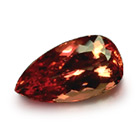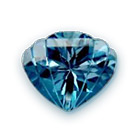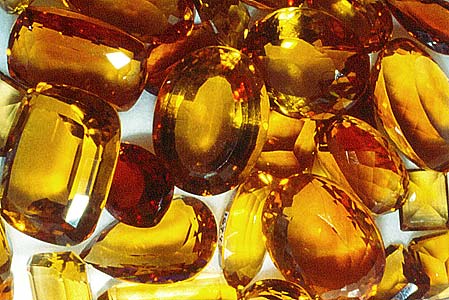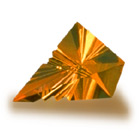The month of NOVEMBER has two widely accepted
birthstones which can have very similar appearances. Both Topaz and
Citrine can occur in the golden-yellow color associated with the month of
NOVEMBER and information on the two stones is found on this page.
TOPAZ and CITRINE
NOVEMBER BIRTHSTONE
Topaz: Gem of the Setting Sun
 The Egyptians said
that topaz was colored with the golden glow of the mighty sun god Ra. This made
topaz a very powerful amulet that protected the faithful against harm. The
Romans associated topaz with Jupiter, who also is the god of the sun. Topaz
sometimes has the amber gold of fine cognac or the blush of a peach and all the
beautiful warm browns and oranges in between. Some rare and exceptional topaz
are pale pink to a sherry red.
The Egyptians said
that topaz was colored with the golden glow of the mighty sun god Ra. This made
topaz a very powerful amulet that protected the faithful against harm. The
Romans associated topaz with Jupiter, who also is the god of the sun. Topaz
sometimes has the amber gold of fine cognac or the blush of a peach and all the
beautiful warm browns and oranges in between. Some rare and exceptional topaz
are pale pink to a sherry red.
Wear topaz only if you wish to be clear-sighted: legend has it that it dispels
all enchantment and helps to improve eyesight as well! The ancient Greeks
believed that it had the power to increase strength and make its wearer
invisible in times of emergency. Topaz was also said to change color in the
presence of poisoned food or drink. Its mystical curative powers waxed and waned
with the phases of the moon: it was said to cure insomnia, asthma, and
hemorrhages.
Perhaps the most famous topaz is a giant specimen set in the Portuguese Crown,
the Braganza, which was first thought to be a diamond. There is also a beautiful
topaz set in the Green Vault in Dresden, one of the world's important gem
collections.
 Brown, yellow, orange,
sherry, red and pink topaz is found in Brazil and Sri Lanka. Pink topaz is found
in Pakistan and Russia.
Brown, yellow, orange,
sherry, red and pink topaz is found in Brazil and Sri Lanka. Pink topaz is found
in Pakistan and Russia.
Today we also have blue topaz, which has a pale to medium blue color created by
irradiation. Pale topaz which is enhanced to become blue is found in Brazil, Sri
Lanka, Nigeria, and China. In early 1998, a new type of enhanced topaz made its
appearance, the surface-enhanced topaz, with colors described as blue to
greenish-blue or emerald green.
Topaz is a very hard gemstone but it can be split with a single blow, a trait it
shares with diamond. As a result it should be protected from hard knocks.
Citrine: Mellow Yellow
 Citrine
is one of the most affordable gemstones, thanks to the durability and
availability of this golden quartz. Named from the French name for lemon,
"citron," many citrines have a juicy lemon color.
Citrine
is one of the most affordable gemstones, thanks to the durability and
availability of this golden quartz. Named from the French name for lemon,
"citron," many citrines have a juicy lemon color.
Citrine includes yellow to gold to orange brown shades of transparent quartz.
Sunny and affordable, citrine can brighten almost any jewelry style, blending
especially well with the yellow gleam of polished gold.
In ancient times, citrine was carried as a protection against snake venom and
evil thoughts.
Although the darker, orange colors of citrine, sometimes called Madeira
citrine after the color of the wine, has generally been the most valued color,
in modern times, many people prefer the bright lemony shades which mix better
with pastel colors. Citrine is generally more inexpensive than amethyst and is
also available in a wide range of calibrated sizes and shapes, including very
large sizes.
Most citrine is mined in Brazil. Supply of citrine is good from the Brazilian
state of Rio Grande do Sul, particularly from the Serra mine, which is
producing 300 kilos a month of hammered goods. The Ira‚ mine produces an
additional 100 kilos a month of hammered goods.
Sometimes you will hear citrine referred to as topaz quartz, which is
incorrect. This name was used in the past in reference to the color, which is
sometimes similar to the color of topaz. Since topaz is a separate mineral,
this type of name can be confusing and should not be used. However, citrine is
considered an alternative to topaz as the birthstone for November.
Since most citrine on the market started its life as amethyst which was heated
to turn its color to gold, citrine jewelry, as well as amethyst jewelry,
should be kept away from prolonged exposure to strong light or heat. With this
precaution, citrine jewelry will last for many generations.
Back
Home
Links
Spotlight
on TKPinc
FAQ
Gem
Information
 The Egyptians said
that topaz was colored with the golden glow of the mighty sun god Ra. This made
topaz a very powerful amulet that protected the faithful against harm. The
Romans associated topaz with Jupiter, who also is the god of the sun. Topaz
sometimes has the amber gold of fine cognac or the blush of a peach and all the
beautiful warm browns and oranges in between. Some rare and exceptional topaz
are pale pink to a sherry red.
The Egyptians said
that topaz was colored with the golden glow of the mighty sun god Ra. This made
topaz a very powerful amulet that protected the faithful against harm. The
Romans associated topaz with Jupiter, who also is the god of the sun. Topaz
sometimes has the amber gold of fine cognac or the blush of a peach and all the
beautiful warm browns and oranges in between. Some rare and exceptional topaz
are pale pink to a sherry red. Brown, yellow, orange,
sherry, red and pink topaz is found in Brazil and Sri Lanka. Pink topaz is found
in Pakistan and Russia.
Brown, yellow, orange,
sherry, red and pink topaz is found in Brazil and Sri Lanka. Pink topaz is found
in Pakistan and Russia. Citrine
is one of the most affordable gemstones, thanks to the durability and
availability of this golden quartz. Named from the French name for lemon,
"citron," many citrines have a juicy lemon color.
Citrine
is one of the most affordable gemstones, thanks to the durability and
availability of this golden quartz. Named from the French name for lemon,
"citron," many citrines have a juicy lemon color.